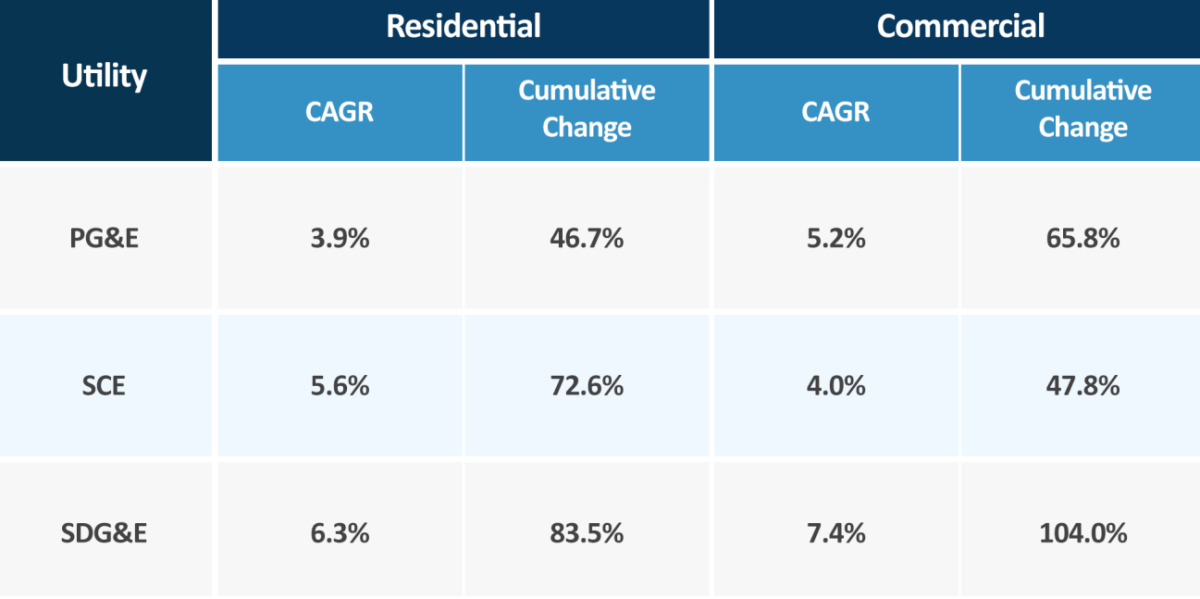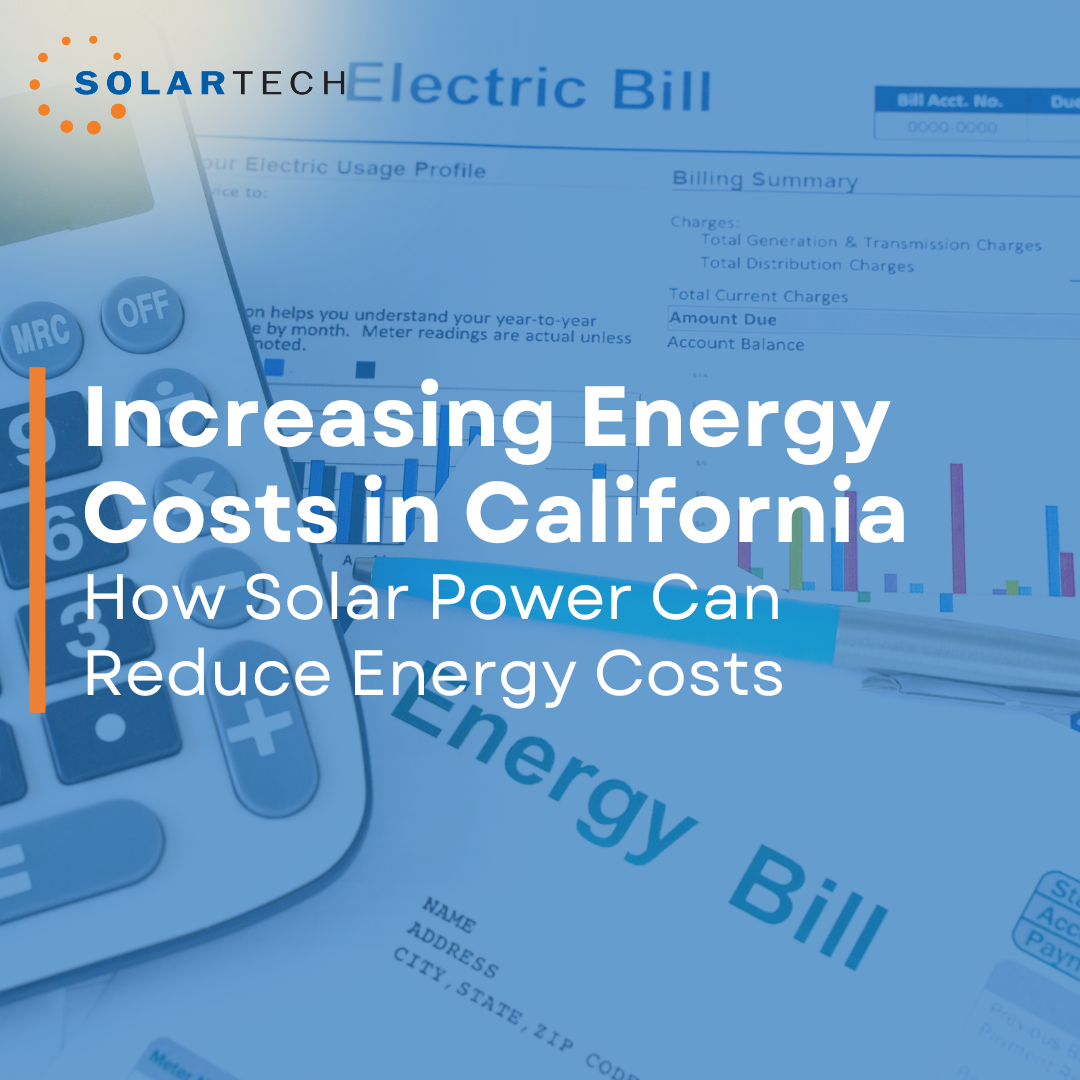Although the recent CPI suggests a 20% deflation in energy commodities and falling electricity prices in many other markets, these trends haven’t materialized in California. “California’s retail prices are out of line with utilities across the country,” said UC Berkeley assistant professor Meredith Fowlie, citing Hawaii and some New England states among the outliers with even higher rates. “And they’re increasing.”
A recent analysis provided by Energy Toolbase, a financial modeling platform specializing in solar and energy storage, evaluated the inflation of California’s electricity rates over the past decade. Their analysis found that the state’s electricity inflation far outpaced national inflation, averaging 15.3% from 2020 through 2023. Over this 9-year period, retail electricity bills from California’s three major utilities rose by at least 47%, with San Diego Gas & Electric spiking 104%. In comparison, the Consumer Price Index (CPI) rose by 28% over the same period.

Source: LinkedIn
Why are California’s energy prices so high?
California’s geography poses challenges for transmitting electricity. It’s a large state with varied terrain and getting electricity from where it’s generated to where it’s needed can be expensive. Moreover, the state is prone to natural disasters like wildfires. When fires threaten power lines, utilities may need to shut off power to prevent fires, leading to disruptions and higher costs. The state’s electricity grid is aging, and upgrades are needed to make it more reliable and resilient. These upgrades can be expensive and may lead to increased costs for consumers.
California has a complex electricity market with a combination of long-term contracts and short-term spot markets. This can lead to price volatility, especially during periods of high demand. California has a cap-and-trade program, which puts a price on carbon emissions. While this is good for the environment, it can increase the cost of fossil fuel-based electricity generation. In some cases, market manipulation by energy companies or traders can result in artificially high electricity prices. The state has taken measures to address this issue.
The state’s population and economy have been growing steadily, leading to increased demand for electricity. Meeting this demand can require costly investments in infrastructure. Additionally, decisions related to energy procurement, incentives, and subsidies can impact electricity prices. California’s strict environmental regulations and high labor costs also lead to the elevated pricing the state has seen for utilities.
Environmental Policies for Solar Change
It’s important to note that while electricity prices in California can be high, the state is also a leader in clean energy and environmental initiatives, which align with its commitment to combat climate change. These policies often result in higher upfront costs but are intended to pay off in the long term through reduced environmental impact and energy security.
This is where solar energy installation comes into play, helping individuals lower their costs of energy one household at a time. Homeowners and businesses can use California’s net metering to receive bill credits for the excess electricity that their solar panels produce, as long as the system is less than 1,000 kilowatts (1 MW). With the help of net metering in CA, electric utility customers who install solar typically save tens of thousands of dollars on their electricity costs over the lifetime of their solar panels.
How Can You Profit from Solar?

Solar panels generate electricity from sunlight, which can be used to power your home’s appliances and lighting. By generating your own electricity, you can significantly reduce your reliance on the grid, resulting in lower electricity bills. Net metering policies in California allow homeowners to feed excess electricity generated by their solar panels back into the grid. When this happens, your utility company may credit your account or pay you for the surplus energy, further reducing your electricity costs.
The state, local, and federal governments offer tax credits and incentives to encourage the adoption of solar energy. These financial benefits can offset a significant portion of the initial installation costs. Solar panels have a long lifespan, typically around 25 years or more. This means that once the initial investment is paid off, you can enjoy many years of reduced energy bills and, in some cases, even generate excess income through net metering.
Why We Recommend Solar
By investing in solar panels, you become more self-reliant when it comes to electricity. This reduces your exposure to rising utility rates and helps you to maintain consistent energy costs, which can be especially beneficial as energy prices tend to increase over time.
Solar energy can help reduce peak demand charges on your energy bill. This is because solar panels typically generate the most energy during peak daylight hours when electricity demand is also high. By using your solar-generated electricity during these times, you can reduce the peak demand charges that are often a part of residential energy bills.
It’s important to note that the extent to which solar energy reduces your energy bill depends on various factors, including your location, the size and efficiency of your solar system, local electricity rates, and your energy consumption habits. A well-designed and properly maintained solar system can offer significant savings over its lifespan.
About SolarTech
SolarTech is a premier, licensed solar provider for California & Arizona, and an accredited member of the Better Business Bureau. We’ve been providing turnkey solar solutions for residential, commercial, and non-profit customers for over 20 years.
Whether we’re installing a residential solar system or a large multi-array commercial solar project, our mission is to inform our customers so they can make the best economic decisions for their energy lifestyle, lower their utility costs, and make a commitment to a better future with clean energy.


